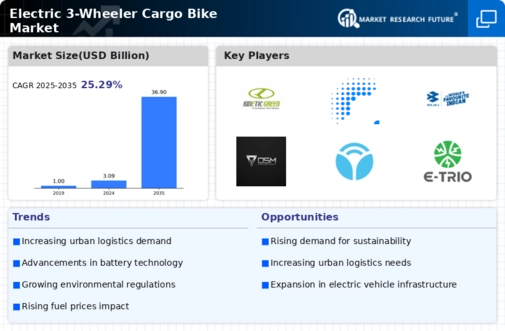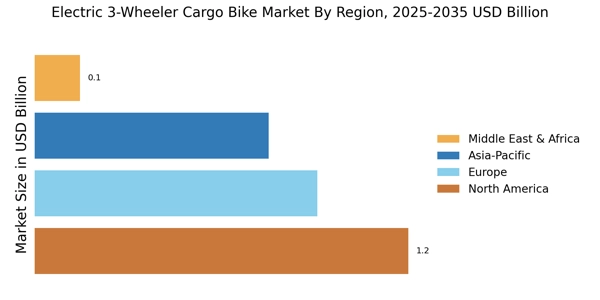Cost Efficiency
Cost efficiency is emerging as a significant driver for the Electric 3-Wheeler Cargo Bike Market. Businesses are increasingly recognizing the long-term savings associated with electric vehicles, particularly in terms of fuel and maintenance costs. Electric 3-wheelers typically have lower operational costs compared to traditional gasoline-powered vehicles, which can lead to substantial savings over time. Market Research Future indicates that companies adopting electric cargo bikes can reduce their logistics costs by up to 25%, making them an attractive option for urban delivery services. This financial incentive is likely to encourage more businesses to transition to electric 3-wheelers, thereby expanding the market and enhancing its overall viability.
Regulatory Support
Regulatory frameworks are increasingly favoring the Electric 3-Wheeler Cargo Bike Market, providing a conducive environment for growth. Many governments are establishing stringent emission regulations that encourage the transition to electric vehicles. This regulatory support often includes tax incentives, grants, and infrastructure development for charging stations, which collectively enhance the attractiveness of electric 3-wheelers. Recent data indicates that regions with supportive policies have witnessed a 30% increase in electric vehicle registrations, underscoring the impact of regulatory measures. As these frameworks become more prevalent, they are likely to drive further adoption of electric cargo bikes, positioning them as a viable alternative in urban logistics.
Urban Delivery Demand
The surge in e-commerce and urban delivery services is significantly influencing the Electric 3-Wheeler Cargo Bike Market. As online shopping continues to gain traction, the need for efficient last-mile delivery solutions has become paramount. Electric 3-wheelers offer a practical alternative to traditional delivery vehicles, particularly in congested urban areas where maneuverability and parking are challenges. Market data indicates that the demand for electric cargo bikes is expected to rise by approximately 15% annually, driven by the need for faster and more sustainable delivery options. This trend is likely to encourage logistics companies to invest in electric 3-wheelers, thereby expanding their fleets and enhancing operational efficiency.
Technological Innovations
Technological advancements play a crucial role in shaping the Electric 3-Wheeler Cargo Bike Market. Innovations in battery technology, electric drivetrains, and smart connectivity are enhancing the performance and efficiency of electric cargo bikes. For instance, the development of lightweight materials and improved battery capacities is enabling longer ranges and faster charging times, making these vehicles more appealing to businesses. Market analysts suggest that the integration of IoT and AI technologies could further optimize fleet management and route planning, leading to cost savings and increased productivity. As these technologies continue to evolve, they are likely to attract more players to the electric 3-wheeler segment, fostering competition and innovation.
Sustainability Initiatives
The increasing emphasis on sustainability is a pivotal driver for the Electric 3-Wheeler Cargo Bike Market. Governments and organizations are actively promoting eco-friendly transportation solutions to reduce carbon emissions and combat climate change. This trend is reflected in various policies and incentives aimed at encouraging the adoption of electric vehicles, including cargo bikes. For instance, several regions have implemented subsidies for electric vehicle purchases, which has led to a notable rise in demand for electric 3-wheelers. The market is projected to grow as more businesses seek to align with sustainability goals, potentially leading to a market size increase of over 20% in the coming years. This shift towards greener logistics solutions is likely to reshape urban transportation dynamics.


















Leave a Comment